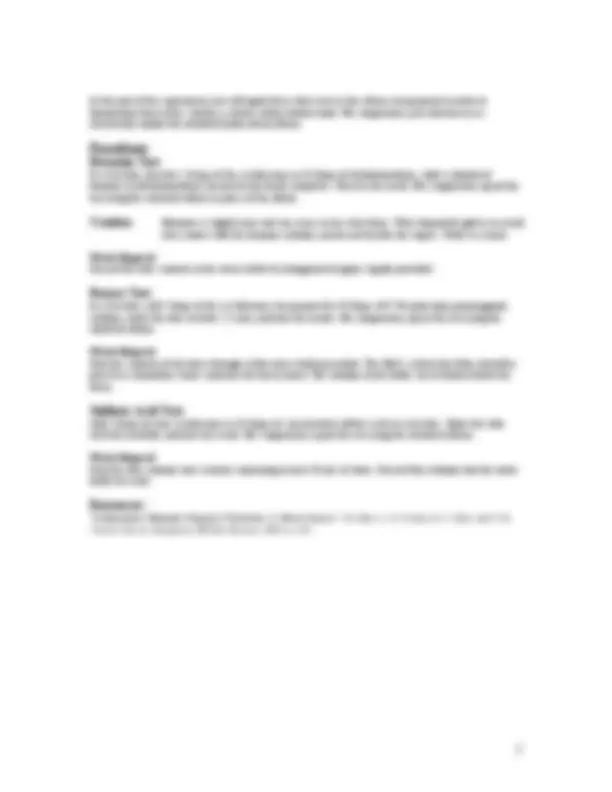



Study with the several resources on Docsity

Earn points by helping other students or get them with a premium plan


Prepare for your exams
Study with the several resources on Docsity

Earn points to download
Earn points by helping other students or get them with a premium plan
Community
Ask the community for help and clear up your study doubts
Discover the best universities in your country according to Docsity users
Free resources
Download our free guides on studying techniques, anxiety management strategies, and thesis advice from Docsity tutors
A laboratory experiment designed to test for the presence of carbon-carbon double bonds in organic compounds using three different methods: the bromine decolorization test, the baeyer test with permanganate, and the sulfuric acid test. The experiment involves the preparation of cyclohexene and a saturated alkane for comparison, and includes procedures, cautions, and waste disposal instructions.
Typology: Study notes
Uploaded on 09/12/2022
1 / 2

This page cannot be seen from the preview
Don't miss anything!


Bromine decolorization is used as a simple qualitative test for unsaturation. Bromine is a dark red-brown liquid, but alkenes and dibromoalkanes are colorless.
C C
alkene (colorless)
bromine (red-brown)
dibromoalkane (colorless)
Br C
Br
Thus, a dilute solution of bromine in an inert colorless solvent, such as dichloromethane, is rapidly decolorized when it is added to an alkene. In contrast, most saturated compounds do not decolorize bromine solutions.
Oxidizing agents also react with carbon-carbon double bonds. This reaction can be used to distinguish alkenes from alkanes. In the Baeyer test, the reagent is alkaline permanganate. When the alkene is oxidized, the reagent is reduced to manganese dioxide. The color change observed is from purple (MnO 4 ¯ ) to brown (MnO 2 ):
C C
purple solution
1,2-diol
OH C
OH 3 +^ 4 H 2 O
brown ppt
3 +^ 2 MnO 2 + 2 K OH
Most alkanes, on the other hand do not react with permanganate under the test conditions.
Although alkanes are inert to cold concentrated sulfuric acid, alkenes react. Either they dissolve to form an alkyl hydrogen sulfate or they produce polymers or tars, which are often dark in color.
C C
an alkyl hydrogen sulfate
H C
OSO 3 H
H OSO 3 H
2
In this part of the experiment, you will apply these three tests to the alkene you prepared in order to demonstrate that it does contain a carbon-carbon double bond. For comparison, you will also test a structurally similar but saturated hydrocarbon alkane.
Procedures
Bromine Test In a test tube, dissolve 2 drops of the cyclohexene in 10 drops of dichloromethane. Add a solution of bromine in dichloromethane (located in the hood), dropwise. Observe the result. For comparison, repeat the test using the saturated alkane in place of the alkene.
Caution Bromine is highly toxic and can cause severe skin burns. Wear disposable gloves to avoid skin contact with the bromine solution, and do not breathe the vapors. Work in a hood.
Waste Disposal Discard the tube contents in the waste bottle for halogenated organic liquids provided.
Baeyer Test In a test tube, add 2 drops of the cyclohexene you prepared to 10 drops of 0.5% potassium permanganate solution, shake the tube well for 1-2 min, and note the results. For comparison, repeat the test using the saturated alkane.
Waste Disposal Pour the contents of the tubes through a filter into a bottle provided. The MnO 2 solid in the filter should be placed in a hazardous waste container for heavy metal. The solution in the bottle can be flushed down the drain.
Sulfuric Acid Test Add 2 drops of your cyclohexene to 10 drops of concentrated sulfuric acid in a test tube. Shake the tube well but carefully, and note the result. For comparison, repeat the test using the saturated alkane.
Waste Disposal Pour the tube contents into a beaker containing at least 20 mL of water. Discard this solution into the waste bottle for acids.
Resources: “Laboratory Manual: Organic Chemistry: A Short Course ” , H. Hart, L. E. Craine, D. J. Hart, and T.K. Vinod 12th ed. Houghton-Mifflin, Boston, 2007; p 107.